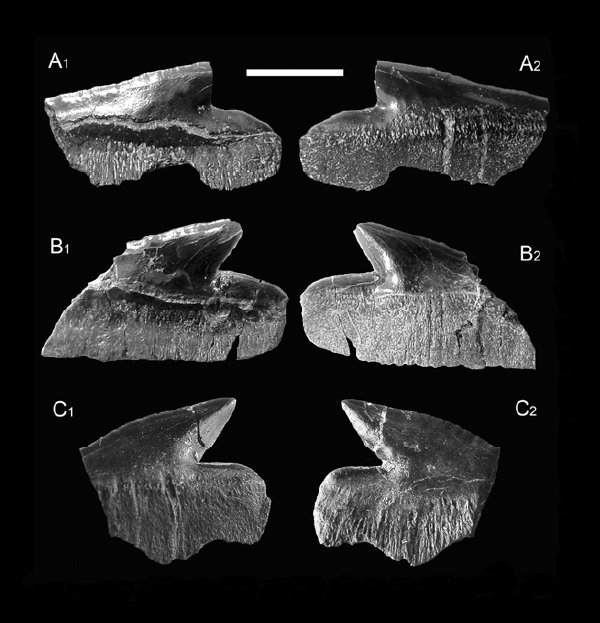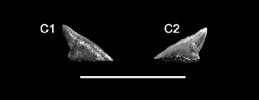Echinorhinus sp.
Classification: Elasmobranchii Echinorhiniformes Echinorhinidae
Types
Echinorhinus sp.
Echinorhinus sp.
Description by Pollerspoeck, Juergen:
Benediktinerring 34, D-94569 Stephansposching; juergen.pollerspoeck@shark-references.comCitation: Echinorhinus sp. : In: Database of fossil elasmobranch teeth www.shark-references.com, World Wide Web electronic publication, Version 01/2026
Please send your images of "Echinorhinus sp." to info@shark-references.com

Echinorhinus sp.; Algarrobo, San Antonio Province, Región de Valparaíso, Chile; Quebrada Municipalidad Strata (Niv. 9), Cretaceous, Maastrichtian, 3 teeth (SGO-PV-6630-6632); © Rodrigo Otero, Chile and Mario E. Suárez, Chile

Echinorhinus sp.; Algarrobo, San Antonio Province, Región de Valparaíso, Chile; Quebrada Municipalidad Strata (Niv. 9), Cretaceous, Maastrichtian, 3 teeth (SGO-PV-6630-6632); © Rodrigo Otero, Chile and Mario E. Suárez, Chile
Distribution Geographic
a: Rødvig, Denmark (one tooth, fragment, MGUH 29916) [18067];
b: Pshekha River, (Krasnodar Region) upstream from the farmstead of Gornyi Luch [17918];
c: near Road D64, in the county of Curnier, 8 km east of Nyons (Drôme, southeast France) [15521];
d: Carrière de Tailledis, Saint-Géours-d'Auribat (Niv. 3-5) France [11] [13];
e: Algarrobo, San Antonio Province, Región de Valparaíso, Chile [15625]
f: Loanco cove, Chanco, Maule, Chile [15626];
g: clay pit near Todtglüsingen, Harburg, Germany [9865];
h: Pobla de Montornés, Spain [156] ( record douptful, no typical denticle of Echinorhinus);
i: Palma (Balearic Islands, Spain) [12275];
j: northwestern Hornby Island, British Columbia, Canada (Manning Point and Collishaw Point) [19279];
k:
Distribution of Echinorhinidae show google map
a: Rødvig, Denmark (one tooth, fragment, MGUH 29916) [18067];
b: Pshekha River, (Krasnodar Region) upstream from the farmstead of Gornyi Luch [17918];
c: near Road D64, in the county of Curnier, 8 km east of Nyons (Drôme, southeast France) [15521];
d: Carrière de Tailledis, Saint-Géours-d'Auribat (Niv. 3-5) France [11] [13];
e: Algarrobo, San Antonio Province, Región de Valparaíso, Chile [15625]
f: Loanco cove, Chanco, Maule, Chile [15626];
g: clay pit near Todtglüsingen, Harburg, Germany [9865];
h: Pobla de Montornés, Spain [156] ( record douptful, no typical denticle of Echinorhinus);
i: Palma (Balearic Islands, Spain) [12275];
j: northwestern Hornby Island, British Columbia, Canada (Manning Point and Collishaw Point) [19279];
k:
Distribution of Echinorhinidae show google map
Distribution Stratigraphy
a: Fish Clay, Cretaceous, Maastricht, [18067];
b: Kuma Horizon (Bathonian), Middle Eocene [17918];
c: Early Cretaceous limestone (Late Hauterivian, Pseudothurmannia ohmi Zone, Pseudothurmannia catulloi Subzone) [15521];
d: Marnes de Donzacq Formation, P9/P10, NP 14: Ypresian, Lutetian [11] [13];
e: Quebrada Municipalidad Strata (Niv. 9), Cretaceous, Maastrichtian, [15625];
f: Strata of Loanco, Cretaceous, Campanian/Maastrichtian [15626];
g: Miocene [9865];
h: Miocene [156] ( record douptful, no typical denticle of Echinorhinus);
i: Pliocene [12275];
j: green to blue-gray shale of the Lambert Formation, late Campanian to early Maastrichtian [19279];
k:
a: Fish Clay, Cretaceous, Maastricht, [18067];
b: Kuma Horizon (Bathonian), Middle Eocene [17918];
c: Early Cretaceous limestone (Late Hauterivian, Pseudothurmannia ohmi Zone, Pseudothurmannia catulloi Subzone) [15521];
d: Marnes de Donzacq Formation, P9/P10, NP 14: Ypresian, Lutetian [11] [13];
e: Quebrada Municipalidad Strata (Niv. 9), Cretaceous, Maastrichtian, [15625];
f: Strata of Loanco, Cretaceous, Campanian/Maastrichtian [15626];
g: Miocene [9865];
h: Miocene [156] ( record douptful, no typical denticle of Echinorhinus);
i: Pliocene [12275];
j: green to blue-gray shale of the Lambert Formation, late Campanian to early Maastrichtian [19279];
k:
Material
c: two teeth [15521];
d: 3 teeth (fragments) [11] [13];
e: 3 teeth (SGO-PV-6630-6632) [15625];
f: 1 tooth (SGO-PV-6625, fig. 2 C1, C2) [15626];
g: 4 deticles [9865];
h: 1 deticle [156], p.117 fig. 8,9 ( record douptful, no typical denticle of Echinorhinus);
i: 1 deticle [12275], p. 58 fig. 9: nr. 1
j:
k:
c: two teeth [15521];
d: 3 teeth (fragments) [11] [13];
e: 3 teeth (SGO-PV-6630-6632) [15625];
f: 1 tooth (SGO-PV-6625, fig. 2 C1, C2) [15626];
g: 4 deticles [9865];
h: 1 deticle [156], p.117 fig. 8,9 ( record douptful, no typical denticle of Echinorhinus);
i: 1 deticle [12275], p. 58 fig. 9: nr. 1
j:
k:
Discussion
CASIER 1966 (p. 501, pl. 1, fig. 8) [421] and KRUCKOW & THIES, 1990 [1352] described the same tooth. The record is douptful.
CASIER 1966 (p. 501, pl. 1, fig. 8) [421] and KRUCKOW & THIES, 1990 [1352] described the same tooth. The record is douptful.
Remarks
shark-references Species-ID=2077;
shark-references Species-ID=2077;
References

A molecular-assisted taxonomic assessment of elasmobranch fishes (Chondrichthyes: Elasmobranchii) from south-eastern Arabia revisited. Zootaxa, 5575(3), 429–446
DOI: 10.11646/zootaxa.5575.3.5

New insights into the identities of the elasmobranch fauna of Sri Lanka. Zootaxa, 4585(2), 201–238
DOI: 10.11646/zootaxa.4585.2.1

Taxonomic assessment of sharks, rays and guitarfishes (Chondrichthyes: Elasmobranchii) from south-eastern Arabia, using the NADH dehydrogenase subunit 2 (NADH2) gene. Zoological Journal of the Linnean Society, 176(2), 399–442
DOI: 10.1111/zoj.12309


Über den Zahnwechsel bei Selachiern. Revue Suisse de Zoologie, 54(19), 305–367

A molecular-assisted taxonomic assessment of elasmobranch fishes (Chondrichthyes: Elasmobranchii) from south-eastern Arabia revisited. Zootaxa, 5575(3), 429–446
DOI: 10.11646/zootaxa.5575.3.5

New insights into the identities of the elasmobranch fauna of Sri Lanka. Zootaxa, 4585(2), 201–238
DOI: 10.11646/zootaxa.4585.2.1

Taxonomic assessment of sharks, rays and guitarfishes (Chondrichthyes: Elasmobranchii) from south-eastern Arabia, using the NADH dehydrogenase subunit 2 (NADH2) gene. Zoological Journal of the Linnean Society, 176(2), 399–442
DOI: 10.1111/zoj.12309


Über den Zahnwechsel bei Selachiern. Revue Suisse de Zoologie, 54(19), 305–367


















